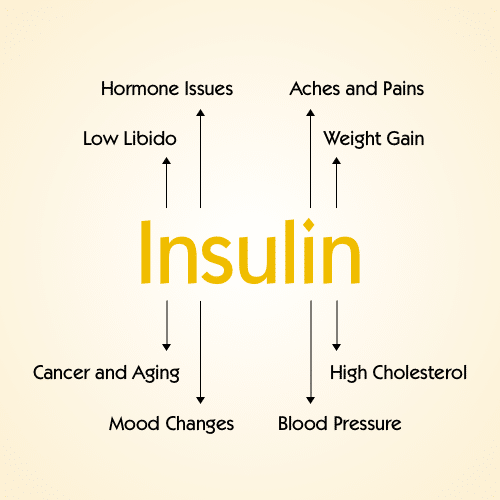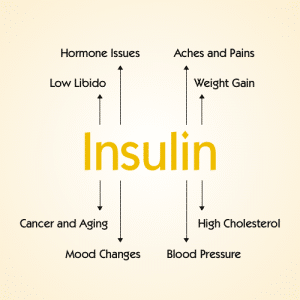
 Most people consider the predominant form of diabetes (type II) to be merely a condition of high blood sugar, but the fundamental problem is much more complex (and interesting). I’ve always felt it important for my patients to understand what is actually going on in their body. As such, one of the talking points for those that are found to have developed insulin resistance (the fundamental problem with type II diabetes) is what’s going on at a deeper level.
Most people consider the predominant form of diabetes (type II) to be merely a condition of high blood sugar, but the fundamental problem is much more complex (and interesting). I’ve always felt it important for my patients to understand what is actually going on in their body. As such, one of the talking points for those that are found to have developed insulin resistance (the fundamental problem with type II diabetes) is what’s going on at a deeper level.
I’ve seen the light go on many times when they finally understand the root problem. In fact, they are always more engaged going forward with the plan to reverse it and have a higher chance of success in that regard. Otherwise, they are simply following instructions. Without the understanding and the engagement, they eventually lose focus and interest then often fail to complete the mission, which is to reverse the diabetes and get off the medications that often have side effects that are worse than the condition itself.
So what is insulin resistance?
The term “insulin resistance” itself explains a lot. First, let’s back up a bit and explain what insulin is exactly. Insulin is a hormone secreted by the pancreas (an organ located behind the stomach) that essentially escorts glucose (blood sugar) into the cells and tissues to be converted into energy. Glucose is stored in our liver, muscles, and other tissues as glycogen. Glycogen waits there until the need for energy arises. Glycogen can be broken down very quickly and released into the blood as glucose.
Once glucose approaches the cells, insulin opens the door through a lock and key mechanism by binding to the insulin receptor. Glucose then enters an organelle called the mitochondria, which you may recall from science class as the “powerhouse of the cell.” Without getting too complex, this is where all the magic happens, i.e. energy production!
What happens when the cells are overloaded by glucose? If an individual consumes sugars or sugar equivalents (bread, pasta, rice, soda, etc.) in large enough amounts and on a frequent enough basis, the cells receive too much glucose and incur damage. Yeah that’s right, too much sugar is a bad thing even for our cells! Sugar has the potential to damage or alter proteins inside the cells. These are called AGE’s, or advanced glycation end products. Somehow the cells’ brain, the nucleus, senses this and decreases the production of insulin receptors being manufactured. This is called “down regulation” and is a phenomena that happens in many areas of human physiology.
The “down regulation” of insulin receptors now leads to less damaging rushes of blood sugar entering the cells. So it really is a protective response that occurs inside the cells that make up tissues such as muscle. The pancreas then responds in kind by INCREASING its production of insulin which, unfortunately, has its own damaging effects outside the cell (i.e. in the blood stream). A fasting insulin blood test is how one can tell if they are insulin resistant LONG BEFORE they develop elevated blood sugar. Asking for a simple blood test to check your fasting insulin will help determine whether or not you have insulin resistance. A value under 5 is where I like to see my patients.
The main problem at this point is, however, that insulin is a pro-inflammatory and pro-fat hormone. The more insulin you have, the more your body wants to store fat. The more fat one has, the more inflammation. This “inflammation” can be measured through a number of blood tests. I almost always find my patients with insulin resistance to also have higher vascular and systemic inflammatory markers.
Inflammation leads to “sticky” vessels and increases production of cholesterol and other plaque-generating lipids. This is why patients with insulin resistance and/or type II diabetes have a much higher incidence of heart attacks and strokes. Systemic inflammation is also strongly correlated with risk for cancer. So if an individual is insulin resistant, inflamed, and overweight, they’re sending all the wrong signals and increasing risk for a whole list of health problems.
The last few paragraphs paint a dismal picture. However, the great news is that type II diabetes CAN BE REVERSED. Trust me on that! Let me cite one example… a 60-year-old male comes to us with diabetes that he’s had for ten or so years. He’s frustrated because he has been on multiple medications and his A1C was around 14 the last time he saw his primary doctor. For those of you who are not familiar with an A1C test, it’s essentially a blood test that provides a three-month picture of how controlled your blood sugar has been. An A1C of 6.5 is defined as “poorly controlled blood sugar.” An A1C of 14 is about as bad as it gets! Six months later the patient had dropped his A1C to 5.9 and was OFF ALL MEDS!
The key points are that it can be done and even the most out-of-control diabetic can be reversed! To reverse insulin resistance, one has to control the messaging to the cells of the their body and more specifically, the brain of the cells, the nucleus. For more on this, stayed tuned for the second part of our series on the keys to reversing type II diabetes.
